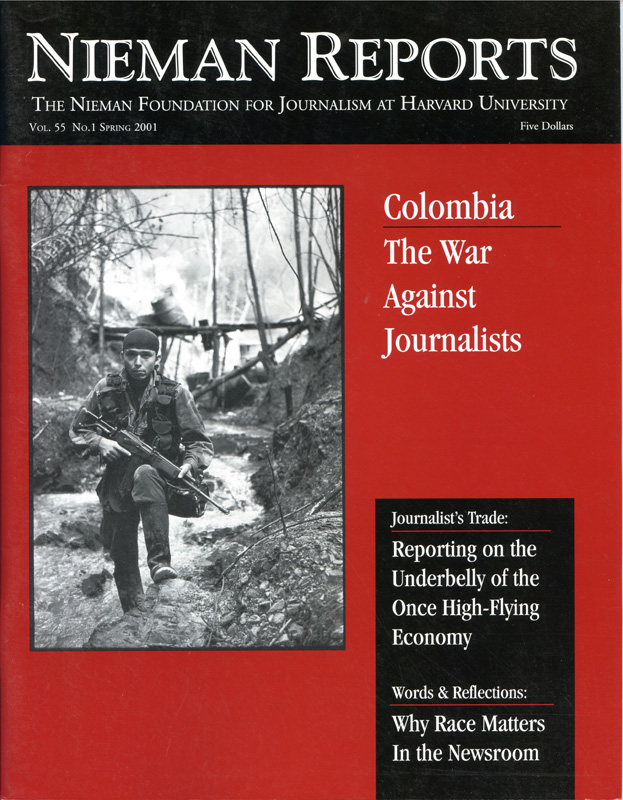Reporting on Colombia’s war is extremely dangerous for journalists. For what they publish and broadcast, reporters are threatened and harassed, kidnapped and beaten, driven into exile and murdered. Only in Algeria have more journalists been murdered during recent years in retaliation for the work they do.
Linda Robinson, a 2001 Nieman Fellow and Latin America correspondent for U.S. News & World Report, begins our series of reports about journalism in Colombia with an overview of why war is being waged, who is fighting whom, and why Americans should care about what is happening. Marylene Smeets, Americas program coordinator at the Committee to Protect Journalists, describes the dangers posed to journalists and the country’s justice system’s lack of response. A five-year time line of crimes against journalists is presented.
Jineth Bedoya Lima, a reporter with El Espectador who was brutally assaulted and tortured by members of the paramilitary forces, writes about that day when “my truth was caught in the middle of the crossfire and was dealt a mortal wound.” Likewise, she says, her nation also suffers a “mortal wound in its truth.” Ignacio Gómez, a 2001 Nieman Fellow and investigative reporter for El Espectador, fled Colombia last year following many death threats and an attempt on his life. Gómez writes about how reporters like him risk their lives to uncover evidence of illegalities and military abuses yet governments—his own and others—balk at pursuing these leads. Francisco Santos, a 1992 Nieman Fellow and editor at El Tiempo, writes from exile about the ways in which violence against journalists leads to self-censorship. Kidnapped and held for eight months by drug cartel leaders in the early 1990’s, Santos continued to face retribution from both guerrillas and paramilitaries for his writings and peace-promoting activities until death threats forced him and his family to flee Colombia in 2000.
Tod Robberson, Latin America bureau chief of The Dallas Morning News, moved his family from Bogotá, Colombia to Panama City, Panama when threats of kidnapping and violence against them intensified. Robberson worries that as U.S. dollars and advisors become more involved in this war, some of the forces might “look for Americans whose abductions might draw some attention to the Colombian plight…they just might settle for the most accessible Americans they can find: journalists.” And Linda Robinson concludes our section of stories with a description of her reporting trip into rebel-held territory. Explaining her reason for taking such a personal risk, she writes, “…the dearth of firsthand reporting from the half of the country where the government was entirely absent seemed to me like an egregious lapse posing a different sort of danger. There was no other way to learn about the FARC except to put myself in their hands. That’s just what reporting on guerrillas requires.”
Steve Salisbury, who has lived and worked as a journalist and photographer in Latin America since 1981, shares with us images from the frontlines of the Colombian conflict.
Linda Robinson, a 2001 Nieman Fellow and Latin America correspondent for U.S. News & World Report, begins our series of reports about journalism in Colombia with an overview of why war is being waged, who is fighting whom, and why Americans should care about what is happening. Marylene Smeets, Americas program coordinator at the Committee to Protect Journalists, describes the dangers posed to journalists and the country’s justice system’s lack of response. A five-year time line of crimes against journalists is presented.
Jineth Bedoya Lima, a reporter with El Espectador who was brutally assaulted and tortured by members of the paramilitary forces, writes about that day when “my truth was caught in the middle of the crossfire and was dealt a mortal wound.” Likewise, she says, her nation also suffers a “mortal wound in its truth.” Ignacio Gómez, a 2001 Nieman Fellow and investigative reporter for El Espectador, fled Colombia last year following many death threats and an attempt on his life. Gómez writes about how reporters like him risk their lives to uncover evidence of illegalities and military abuses yet governments—his own and others—balk at pursuing these leads. Francisco Santos, a 1992 Nieman Fellow and editor at El Tiempo, writes from exile about the ways in which violence against journalists leads to self-censorship. Kidnapped and held for eight months by drug cartel leaders in the early 1990’s, Santos continued to face retribution from both guerrillas and paramilitaries for his writings and peace-promoting activities until death threats forced him and his family to flee Colombia in 2000.
Tod Robberson, Latin America bureau chief of The Dallas Morning News, moved his family from Bogotá, Colombia to Panama City, Panama when threats of kidnapping and violence against them intensified. Robberson worries that as U.S. dollars and advisors become more involved in this war, some of the forces might “look for Americans whose abductions might draw some attention to the Colombian plight…they just might settle for the most accessible Americans they can find: journalists.” And Linda Robinson concludes our section of stories with a description of her reporting trip into rebel-held territory. Explaining her reason for taking such a personal risk, she writes, “…the dearth of firsthand reporting from the half of the country where the government was entirely absent seemed to me like an egregious lapse posing a different sort of danger. There was no other way to learn about the FARC except to put myself in their hands. That’s just what reporting on guerrillas requires.”
Steve Salisbury, who has lived and worked as a journalist and photographer in Latin America since 1981, shares with us images from the frontlines of the Colombian conflict.



